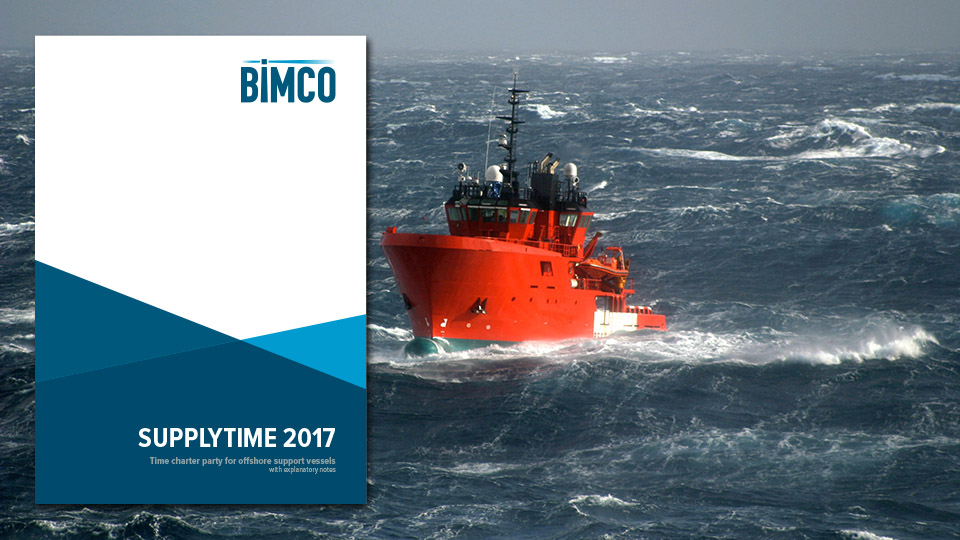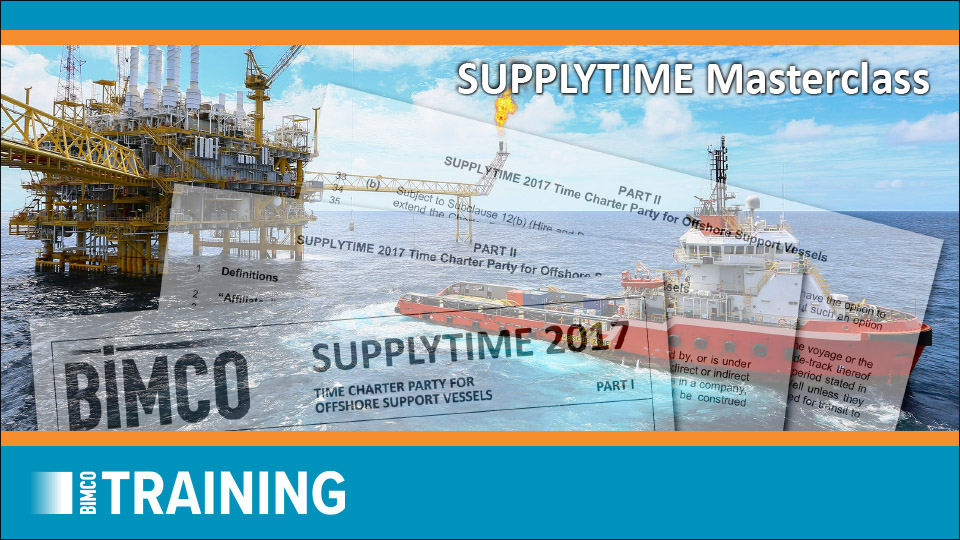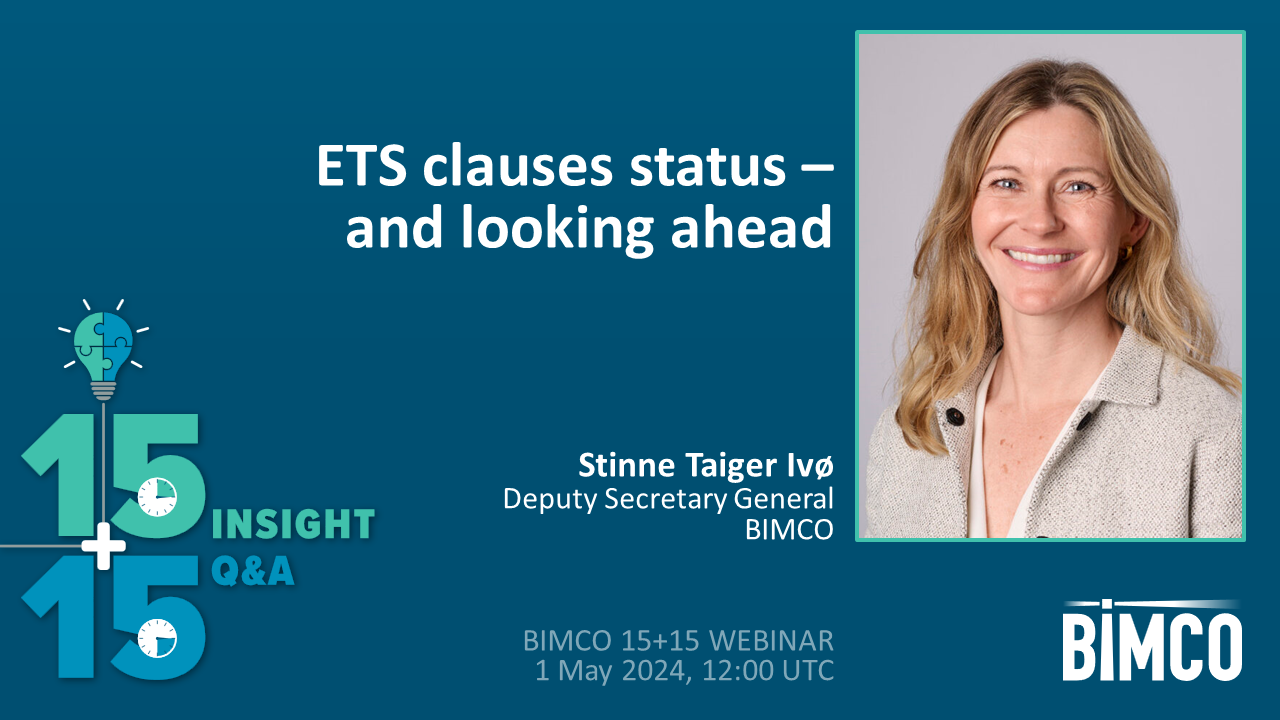WRECKFIXED 2010
Overview
WRECKFIXED 2010 is an international wreck removal and marine services agreement based on a fixed price and on the principle of no cure, no pay. The latest edition of this contract is WRECKFIXED 2010.
Copyright in WRECKFIXED 2010 is held by BIMCO.WRECKFIXED 2010
Supporting documents
-
0.3 MB
Sample copy of WRECKFIXED 2010
Download now
Explanatory notes
The following explanatory notes are intended to provide users with guidance as to the nature and extent of changes made to the WRECKFIXED 99 form.
- Clause 1 (Definitions)
- Clause 2 (The Services)
- Clause 3 (Company Representative)
- Clause 4 (Change of Method of Work and/or Personnel, Craft and Equipment)
- Clause 5 (Miscellaneous)
- Clause 6 (Permits)
- Clause 7 (Termination)
- Clause 8 (Delivery and/or Disposal)
- Clause 9 (Payment)
- Clause 10 (Extra Costs)
- Clause 11 (Security)
- Clause 12 (Liabilities)
- Clause 13 (Himalaya Clause)
- Clause 14 (Lien)
- Clause 15 (Time for Suit)
- Clause 16 (Expert Evaluation)
- Clause 17 (Arbitration and Mediation)
- Clause 18 (Notices Clause)
- Clause 19 (Insurance)
- Clause 20 (Pollution)
- Clause 21 (Rotation and Replacement of craft, equipment and personnel)
- Clause 22 (General Provisions)
PART I Box Layout
Part I of WRECKFIXED 2010 is largely unchanged from the ’99 edition of the form. Box 4 (Vessel Specifications) has been expanded to include the vessel’s IMO number and the P&I Club/insurer. Box 7 (Nature of Services) now requires two fields to be completed: (i) a description of the nature of the services; and (ii) the party responsible for obtaining confirmation of compliance by the Company with the orders issued by competent authorities.
Box 9 (Permits) has been removed as the revised agreement now requires the Contractors to obtain and maintain the necessary permits (with the assistance of the Company as appropriate).
Part II
Clause 1 (Definitions)
A number of new definitions have been added to the agreement to improve the overall clarity of the form. The new definitions include “Company”, “Contractor”, “Services” and “Worksite” all of which were terms already used in WRECKFIXED, but not defined. There is now a consistent use of these defined terms through the Agreement.
Clause 2 (The Services)
This Clause deals with the Contractors’ obligations in providing the agreed services, as well as the provision of personnel, craft and equipment, the method of work, and any change in the method of work, or provision of personnel, craft and equipment. Consistent with the approach taken in the 1989 Salvage Convention, the Contractor is obliged to exercise “due care” when providing the services. Provided that it is not inconsistent with the nature of the services to be rendered, the Contractor must also exercise “due care” to prevent and minimise damage to the environment.
The first paragraph of Clause 2 has been amended to make the delivery and/or disposal of the vessel a “due diligence” type obligation on the part of the Contractor. The previous reference to the Contractor’s “endeavour to deliver” has been removed as the obligation to exercise “due care” applies to all of the agreed services under the Agreement, which may also include delivery and/or disposal.
In the last sentence of the first paragraph the Contractor now has to exercise due care to “prevent” as well as minimise damage to the marine environment. This has been done to be consistent with the phrasing used in the newly introduced Clause 20 (Pollution).
Two new provisions have been added at the end of Clause 2. The first requires the Contractor to give the Company Representative, if in attendance at the site, daily reports (the reports to be based on a standard format set out in Annex III (Contractor’s Daily Reports)). The second new provision requires assistance to be given to the party named in Box 7(ii) by the other party to assist in obtaining confirmation from the authorities of compliance with their orders.
Clause 3 (Company Representative)
This Clause provides for a representative of the Company to be available onsite, but only if required by the Contractor. A previous reference to the Company being obliged to provide information to the Contractor has been moved to the final part of Clause 5 (Miscellaneous)
The Clause also deals with the attendance on site, at the Company’s risk and expense, of ship’s personnel who are fully conversant with the layout of the Vessel and its cargo system in order to provide advice to the Contractors.
Clause 4 (Change of Method of Work and/or Personnel, Craft and Equipment)
Problems may arise during the operation that require a substantial change of method, equipment, etc. This Clause deals with the circumstances under which the Contractor may seek a variation to the Fixed Price stated in Box 9.
Clause 4 has been substantially restructured and split into three distinct sections. The first section (sub-clause (a)) deals with substantial changes before or during the services resulting in additional costs. The second section (sub-clause (b)) deals the task becoming easier due to a change in circumstances and where the Company can ask for a reduction in the money due to the Contractor. In both cases the parties must agree to a work variation order and to any increase or decrease in costs. In sub-clause (c) provision is made for the parties to resolve any disagreement in respect of sub-clauses (a) and (b) by referring the matter to a new expert evaluation procedure or to mediation or arbitration.
The previous method of referring the matter solely to arbitration was felt to be too slow and inefficient for this type of dispute where it is essential that work is not interrupted or delayed awaiting the outcome of an arbitrator’s decision. In any event the Contractor is obliged to continue operations pending the outcome of any evaluation, mediation or arbitration.
Clause 5 (Miscellaneous)
This Clause, which is largely unchanged from the WRECKFIXED 99 edition, deals with matters such as the marking of the Vessel; use of the Vessel’s machinery and equipment; removal or jettison of parts of the Vessel and/or its cargo, and provision of plans and manifests.
In sub-clause (d) the strict obligation on the Company to provide the Contractors with plans, drawings and other data/information has been amended to “best endeavours” as the Company may simply not be in possession of some of the requested information. The Contractors are at liberty to request the Company to provide plans, drawings and information (previously, the requirement to provide information was found in Clause 3 (Company Representative)) but such requests must be “reasonable”.
Clause 6 (Permits)
This Clause deals with the need to obtain licences, approvals, authorisations and permits. The Permits Clause previously allowed for either party to be designated as responsible for obtaining permits. This has now been amended to make the Contractor solely responsible for this task although the Company is required to assist where necessary (for example in situations where a particular permit can only be issued to the shipowner or where the submission of certificates held by the shipowner is required). This amendment reflects the reality of salvage operations where the on-site contractor is best placed to obtain the necessary permits.
Clause 7 (Termination)
This Clause remains unchanged from WRECKFIXED 99. It sets out the circumstances under which the Agreement may be terminated by the Company (sub-clause 7(a)); and the manner in which the termination of the Agreement will be carried out by the Contractor (sub-clause 7(b)).
Clause 8 (Delivery and/or Disposal)
The Clause has been amended to take account of situations where the Contractors also agree to dispose of the vessel or part of the vessel. “Part” of the vessel includes cargo and bunkers and it is recognised that disposal of such items may take place at different locations and at different times from the disposal of other parts of the vessel.
Clause 9 (Payment)
The new Payment Clause is the result of the merging of the old Clause 9 (Price and Conditions of Payment) and Clause 10 (Time of Payment and Interest).
Clause 9 is fundamental to the proper working of the Agreement. Sub-clauses (9(a) and 9(b) deal with the payment of the agreed Fixed Price on completion of the services without deduction; Sub-clause (c) provides for the Fixed Price to be paid in the agreed currency to the stated bank account; Sub-clause (d) gives the Contractor a right of termination in the event that payment is not made in accordance with the terms of the Agreement, or if security is not provided in accordance with the provisions of Clause 11 (Security); and Sub-clause (e) enables the Contractors to charge the Company interest at the agreed rate in the event any sums due and payable are not received by the Contractors within the agreed period.
Clause 10 (Extra Costs)
This Clause is largely unchanged from the ’99 edition and provides for any various extra costs incurred to be for the account of the Contractor. A new Sub-clause (e) obliges the Contractor to meet the cost of obtaining and maintaining licenses and permits needed to undertake the salvage operation.
Clause 11 (Security)
This Clause remains unchanged from WRECKFIXED 99. The Security Clause requires the Company to provide an irrevocable and unconditional security in any form as agreed between the parties. The Company is required to provide satisfactory security to cover monies due to the Contractor. The Contractor may also commence operations without the provision of initial security, but can request it to be provided at a later stage when “reasonably” required.
Clause 12 (Liabilities)
Clause 12 provides the usual knock for knock provisions common in offshore contracts. Sub-clauses (a), (b), (c) and (d) have been slightly modified to include “sub-contractors” (which reflects the common use by salvors of third party sub-contractors). Sub-clause 12(e) is new and replaces the old consequential losses provision which was felt to be ineffective. The new wording is taken from TOWHIRE 2008, the consequential losses provision of which has been positively received by lawyers previously critical of BIMCO consequential liability provisions.
Clause 13 (Himalaya Clause)
This Clause is the same as that found in WRECKFIXED 99.
Clause 14 (Lien)
This Clause is the same as that found in WRECKFIXED 99.
Clause 15 (Time for Suit)
This Clause remains largely unchanged from the ’99 edition. The previous reference to notification by “telex, facsimile, cable or otherwise in writing” has been deleted because methods and forms of notification are now dealt with by a new Notices Clause (see Clause 18).
Clause 16 (Expert Evaluation)
WRECKFIXED 2010 introduces a new method of dealing with certain types of dispute under the Agreement - notably an adjustment of costs following a change to the nature of the services (Clause 4). It was felt that the standard BIMCO Dispute Resolution Clause used in most BIMCO forms is simply not well suited to resolving issues that require a more or less on-the-spot decision so that work is not interrupted. Conventional arbitration lacks the infrastructure and expertise to determine such types of disputes. Therefore a two-tier approach to dispute resolution has been introduced.
In the first instance, if the parties cannot agree to additional costs for a change in the nature of the services, or are in dispute as the application of the standby rate, they may refer the disagreement to an “expert evaluator”. It is intended that the role of the “expert evaluator” will be assumed by a SCR (Special Casualty Representative) chosen from the Panel of SCRs maintained by the Salvage Arbitration Branch of Lloyd’s. Once appointed, the SCR acting as “expert evaluator” will take into account short written submissions provided by each party and then within 72 hours give written advice to the parties as to how costs/rates should be adjusted or how time should be accounted for. The cost of such an evaluation is to be met by both parties.
It is important to note that the evaluation is not binding on either party. The intention is to take impartial advice so as to not delay or further delay the salvage operation. The parties only agree that whatever the SCR proposes is given immediate effect but without prejudicing their right to resolve the dispute by conventional arbitration/mediation methods set out in Clause 17 at a later date.
Clause 17 (Arbitration and Mediation)
The Arbitration and Mediation Clause of WRECKFIXED 2010 builds on the “Governing Law and Arbitration” Clause in WRECKFIXED 99 which makes special provision for using Lloyd’s Salvage Arbitrators who are experts in resolving salvage related disputes. Consistent with the current BIMCO standard Dispute Resolution Clause, the parties may choose an applicable law and arbitration venue from a choice of English law/London arbitration; US law/New York arbitration; or a choice of law and arbitration as chosen and agreed by the parties.
The Clause incorporates the LMAA’s recently introduced intermediate claims procedure to supplement the existing small claims procedure. The Clause also introduces new mediation provision which permits the parties to refer all or part of a dispute, for which arbitration has been commenced, to mediation.
Clause 18 (Notices Clause)
The notices provision is new but is a provision commonly found in other recently produced BIMCO standard forms. The Clause provides that all notices must be in writing and sent using one of the prescribed formats. The Clause also sets out when notices given under the Agreement take effect depending on the method of communication used.
Clause 19 (Insurance)
This is another new Clause for WRECKFIXED and provides for each party to warrant that they have in place appropriate insurance cover.
Clause 20 (Pollution)
This Clause is also new and requires the Contractor to exercise “due care” to prevent and minimise damage to the environment and have in place an oil spill response plan which meets the requirements of the Authorities and the Company. Sub-clauses (b) and (c) provide knock-for-knock provisions in relation to pollution from the vessel and the Contractor’s vessels.
Clause 21 (Rotation and Replacement of craft, equipment and personnel)
This is another new provision that basically gives the Contractor the right to swap resources/equipment in and out of the salvage operation for maintenance and/or fatigue-relief purposes.
Clause 22 (General Provisions)
This set of clauses covering the enforceability of provisions; third party beneficiaries; no-waiver; and warranty of authority, reflect additional clauses commonly added to wreck removal and other marine service agreements used in the salvage/offshore industry.
Annexes
Annex I (Schedule of Personnel, Craft and Equipment) and Annex II (Method of Work and Estimated Time Schedule) are unchanged from the previous edition of WRECKFIXED.
A new Annex III has been added to provide a proforma template for the Contractor’s daily reports.
Related Help & Advice
Create or edit a contract
The one-stop digital shop for all the standard maritime contracts and clauses you’ll ever need.
Latest Related News
-
BIMCO publishes ship financing forms to ensure uninterrupted use of ships
BIMCO has published two standard Quiet Enjoyment Letters (QELs), the first standard form QELs available to the industry, to offer a tool that can ensure the charterers’ uninterrupted use of a ship if the owner defaults under the financing facility.
-
BIMCO starts work on contract for growing wind turbine market
BIMCO has established a subcommittee to work on a global standard contract for the transport and installation of offshore wind turbines. The project has been launched to support the offshore wind industry as the global demand for more renewable sources of energy increases.
-
BIMCO approves revised SYNACOMEX grain charter
BIMCO’s Documentary Committee has approved a revised version of the Continent Grain Charter Party, SYNACOMEX, to reflect changes in the geopolitical landscape following events including the COVID-19 pandemic and the war in Ukraine. The revised charter party now includes BIMCO’s anti-corruption clause and updated versions of the war risks and sanctions clauses.
-
BIMCO publishes updated GENCON contract
BIMCO has published a revised and updated version GENCON 2022 - one of its flagship contracts within its portfolio of standard contracts for the maritime industry. The revisions reflect significant changes in the regulatory landscape since the contract was last updated.
-
BIMCO launches ship sale and purchase agreement
BIMCO has produced its own ship sale and purchase agreement - SHIPSALE 22 – with the aim of making the authoring, negotiation and execution process faster and simpler, and to provide the market with a modern and comprehensive alternative to existing sale and purchase forms.
ELSEWHERE ON BIMCO
Holiday calendar
BIMCO's Holiday Calendar covers general holidays in over 150 countries, plus local holidays and working hours in more than 680 ports around the world.
Taxes, tariffs & charges
Access information on national, regional or port tariffs, taxes and charges.
Learn about your cargo
For general guidance and information on cargo-related queries.





